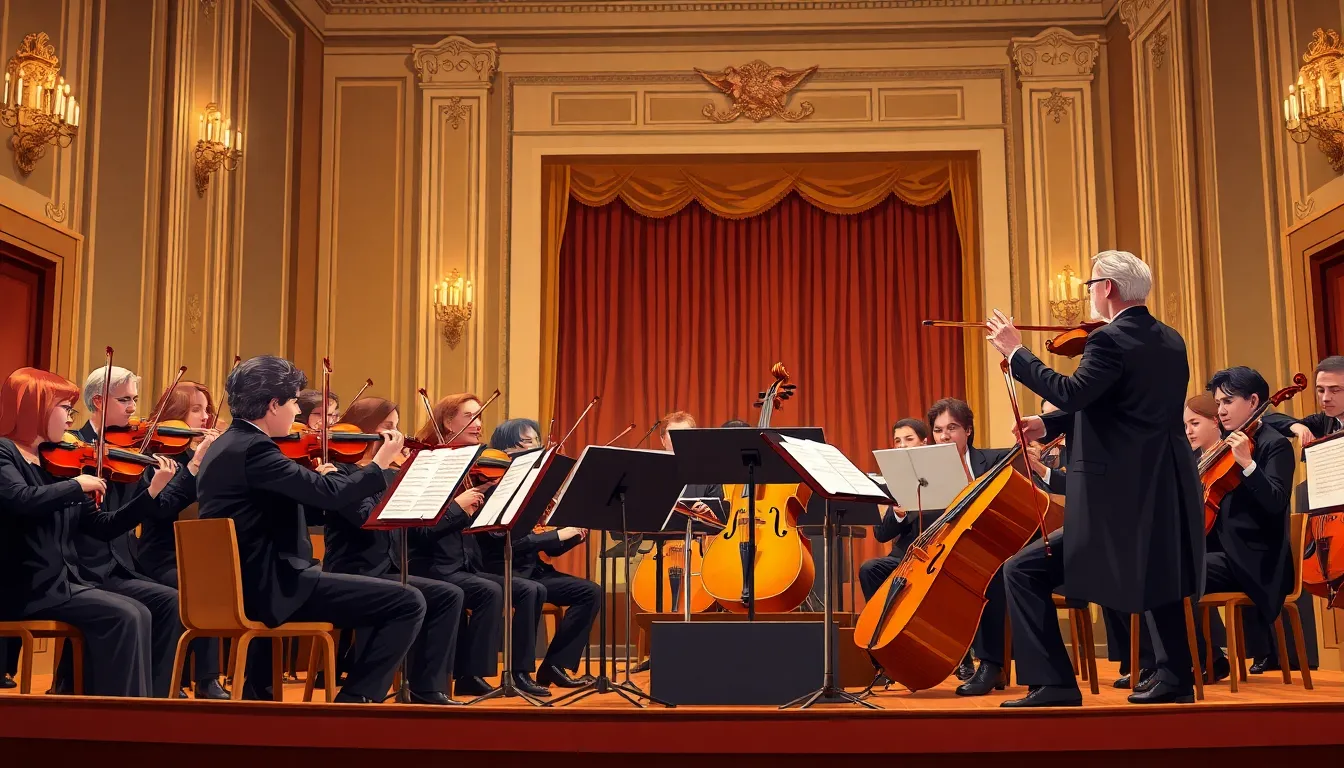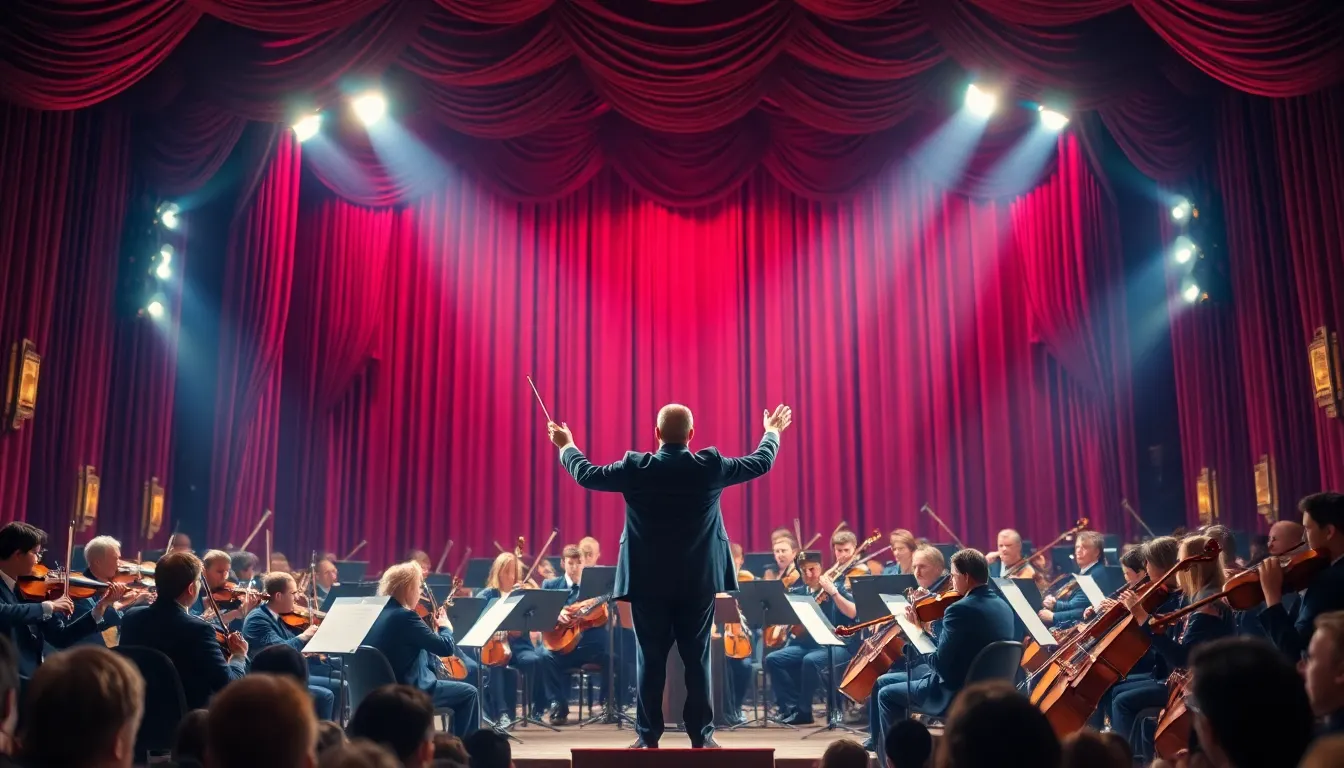Imagine walking into a grand theater, the lights dim, and the unmistakable sound of an overture fills the air. It’s not just music; it’s a thrilling invitation to a world of drama, romance, and sometimes a bit of chaos. Famous overtures have the power to set the stage, capturing emotions and enticing audiences long before the curtain rises.
Table of Contents
ToggleOverview of Famous Overtures
Famous overtures serve as essential introductions to operas, ballets, and musicals. These orchestral pieces set the tone and establish thematic elements that resonate throughout the performance. One of the most celebrated examples is “The Marriage of Figaro” by Wolfgang Amadeus Mozart, which exudes lively energy and anticipation. Another significant overture is Rossini’s “William Tell,” recognized for its dramatic crescendos that mirror the narrative’s intensity.
Other renowned works include Beethoven’s “Egmont,” which captures a spirit of heroism and struggle. The “Overture to A Midsummer Night’s Dream” by Felix Mendelssohn presents whimsical melodies that reflect the play’s enchanting atmosphere. Verdi’s “Overture to La Forza del Destino” contains powerful themes that engage the listener with its emotional depth.
Overtures also vary in style and instrumentation. Many incorporate distinctive motifs that reappear in the main work. “Candide” by Leonard Bernstein exemplifies this, seamlessly blending operatic and theatrical elements. Each overture is carefully crafted to enhance the viewer’s experience, highlighting the music’s integral role in storytelling.
The impact of these overtures extends beyond classical music. They create memorable moments in pop culture, often featured in films and commercials, further embedding them into the collective consciousness. Recognizing these famous overtures enriches the overall appreciation of the arts, inviting audiences to explore the broader context of each performance.
Historical Context

Overtures hold a significant place in the realm of theater music. Their development has mirrored the changing styles and forms of the dramatic arts.
The Evolution of Overtures
The late 17th century marked the rise of overtures in opera, initially serving simply as introductory pieces. Composers gradually shaped these compositions into more complex forms. By the Classical period, overtures began to feature thematic elements from the main works. Romantic composers further expanded the orchestration and emotional depth of these introductions, enhancing their dramatic impact. The evolution continued into the 20th century with innovative approaches, reflecting a wide range of musical styles. Today, overtures blend traditional elements with contemporary influences, illustrating their adaptability.
Key Composers of Overtures
Several composers played crucial roles in defining the overture’s character. Mozart’s inventive approach brought sophistication to the form, evident in “The Marriage of Figaro.” Rossini’s energetic and playful style revolutionized the genre, particularly seen in “William Tell.” Beethoven broke new ground with his dramatic scores, notably “Egmont,” showcasing the emotional power of overtures. Mendelssohn’s “Overture to A Midsummer Night’s Dream” exemplifies the melding of narrative and music. Verdi’s works, such as “Overture to La Forza del Destino,” further cemented the importance of overtures within operatic contexts. Each composer contributed unique elements, enriching the legacy of overtures across different musical eras.
Notable Famous Overtures
Famous overtures play a significant role in setting the stage for operas and musicals. These compositions establish mood and immerse the audience in the performance’s themes.
Overture to “The Marriage of Figaro” by Mozart
Mozart’s overture to “The Marriage of Figaro” brilliantly combines lively themes and harmonic richness. Its rapid tempo and playful motifs create anticipation for the comedic twists and turns of the opera. This piece encapsulates the underlying tensions between social classes and personal desires, enhancing the narrative’s depth. The overture’s energetic crescendos exemplify Mozart’s mastery of orchestration, inviting listeners into the world of Figaro and Susanna. Themes echo throughout the opera, connecting various characters and plots brilliantly.
Overture to “William Tell” by Rossini
Rossini’s overture to “William Tell” exemplifies dynamic contrasts and vivid storytelling, beginning with a serene introduction. This tranquil section builds tension, eventually leading to an exhilarating finale. The galloping rhythms reflect the action-packed scenes of the opera, capturing the spirit of Swiss nationalism. Within this composition, Rossini integrates folk-like melodies, enhancing its emotional resonance. Its lasting popularity is evident, frequently appearing in films and commercial music.
Overture to “The Barber of Seville” by Rossini
“The Barber of Seville” features a charming overture that showcases Rossini’s incredible flair for melody. The vivacious tempo and witty motifs entice audiences, foreshadowing the humorous escapades of Figaro and his clever plot twists. Rossini employs a blend of orchestral colors, creating a lively backdrop that complements the opera’s mischievous spirit. Each musical phrase echoes the characters’ antics, uniting the audience’s emotions with the unfolding drama. This overture remains a cherished favorite in concert halls and operatic performances.
Overture to “Egmont” by Beethoven
Beethoven’s “Egmont” overture serves as a powerful introduction to the themes of heroism and sacrifice. Its contrasting sections evoke a range of emotions, from despair to triumph. The overture begins with a somber atmosphere, gradually building to a climactic resolution that symbolizes victory. This transformation in mood reflects the opera’s narrative arc, highlighting the struggle against oppression. The overture is celebrated for its philosophical depth, making it a staple in concert repertoire.
The Role of Overtures in Opera and Concerts
Overtures serve as essential introductions, establishing the mood for operas, ballets, and concerts. They engage audiences by setting thematic elements and providing a preview of the upcoming performance. Composers use overtures to encapsulate core emotions, allowing listeners to grasp the essence of the narrative before it unfolds.
Mozart’s “The Marriage of Figaro” exemplifies this role with its lively music, which creates immediate anticipation. Dynamic contrasts in Rossini’s “William Tell” overture draw listeners into a narrative brimming with adventure. Emotional depth characterizes Beethoven’s “Egmont,” where themes of heroism resonate powerfully.
In addition to heightening excitement, overtures often introduce memorable motifs. These motifs can recur throughout the main work, linking various scenes or acts and enriching the audience’s experience. Cultural impact extends beyond the stage, as audiences encounter these pieces in films and commercials, fostering a deeper appreciation for their artistry.
Historical evolution reveals how overtures transformed from simple introductions in the late 17th century into intricate compositions during the Classical and Romantic periods. Verdi’s overture to “La Forza del Destino” showcases the development of dramatic intensity, incorporating rich instrumental textures and expressive melodies.
Contemporary composers continue to innovate, blending traditional elements with modern influences in overtures. Their ongoing relevance highlights an adaptability that keeps performances fresh while honoring established traditions. Overtures thus remain a vital component in the landscape of theater music, enhancing the overall emotional experience and connection to the narrative.
Famous overtures serve as a bridge between the audience and the unfolding drama. They encapsulate the essence of the performances that follow while drawing listeners into a world of emotion and anticipation. Each overture, from Mozart to Verdi, showcases the unique artistry of its composer, revealing themes that resonate throughout the main work.
As overtures continue to evolve, they remain a crucial part of theatrical music. Their ability to blend tradition with modern influences ensures that they captivate new generations of audiences. The lasting impact of these iconic pieces reinforces their significance in the cultural landscape, inviting everyone to explore the rich narratives they introduce.



